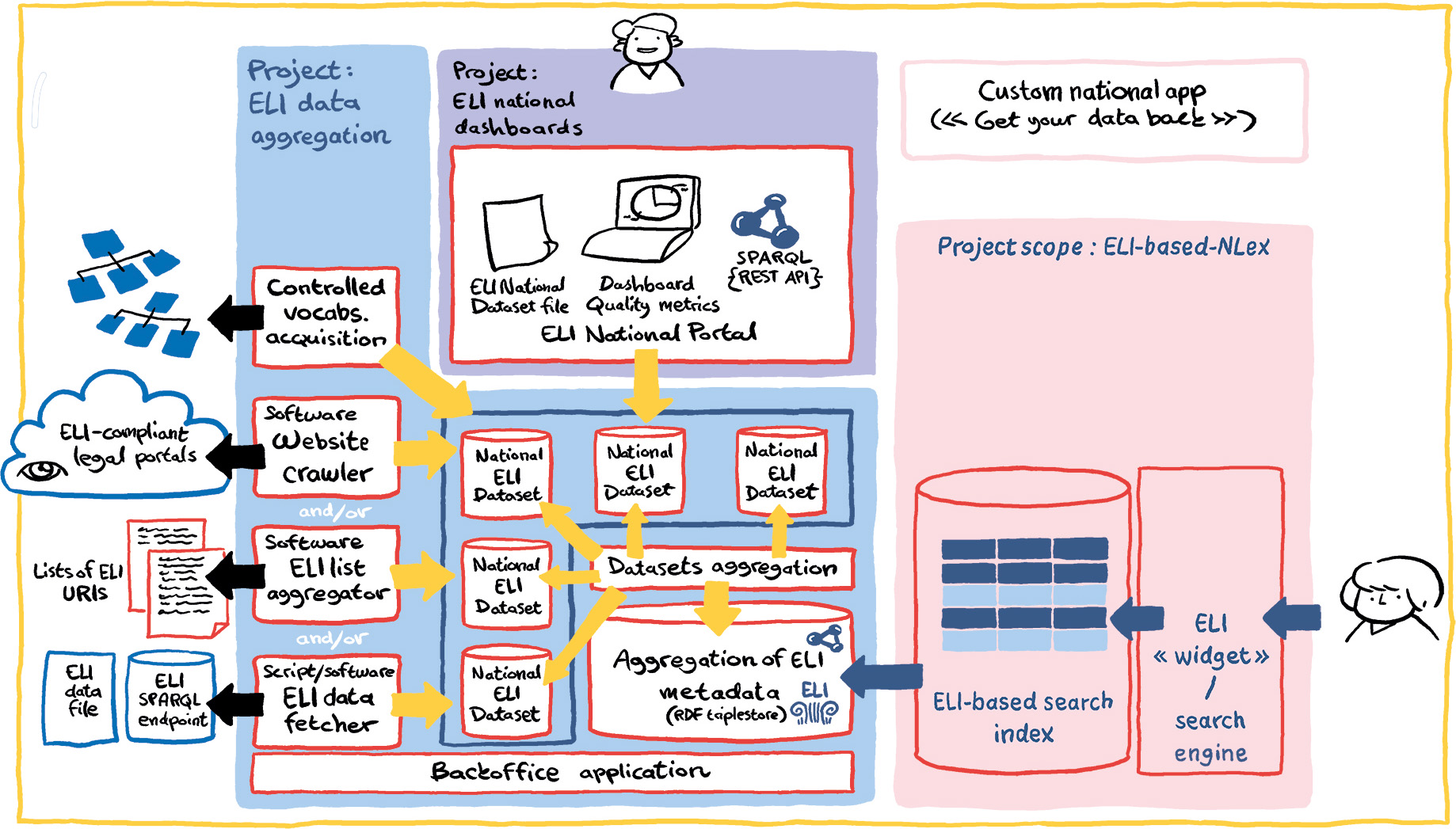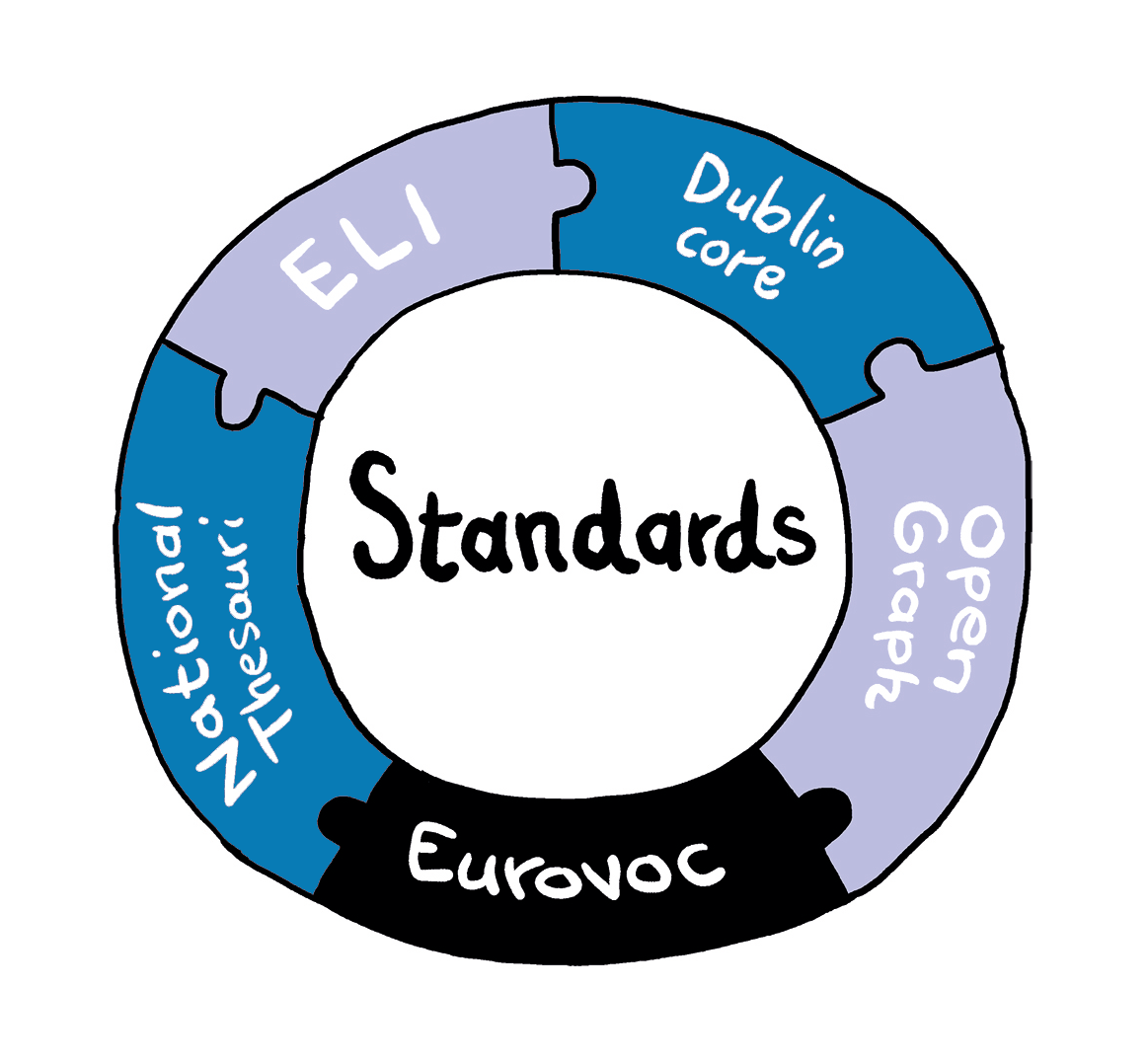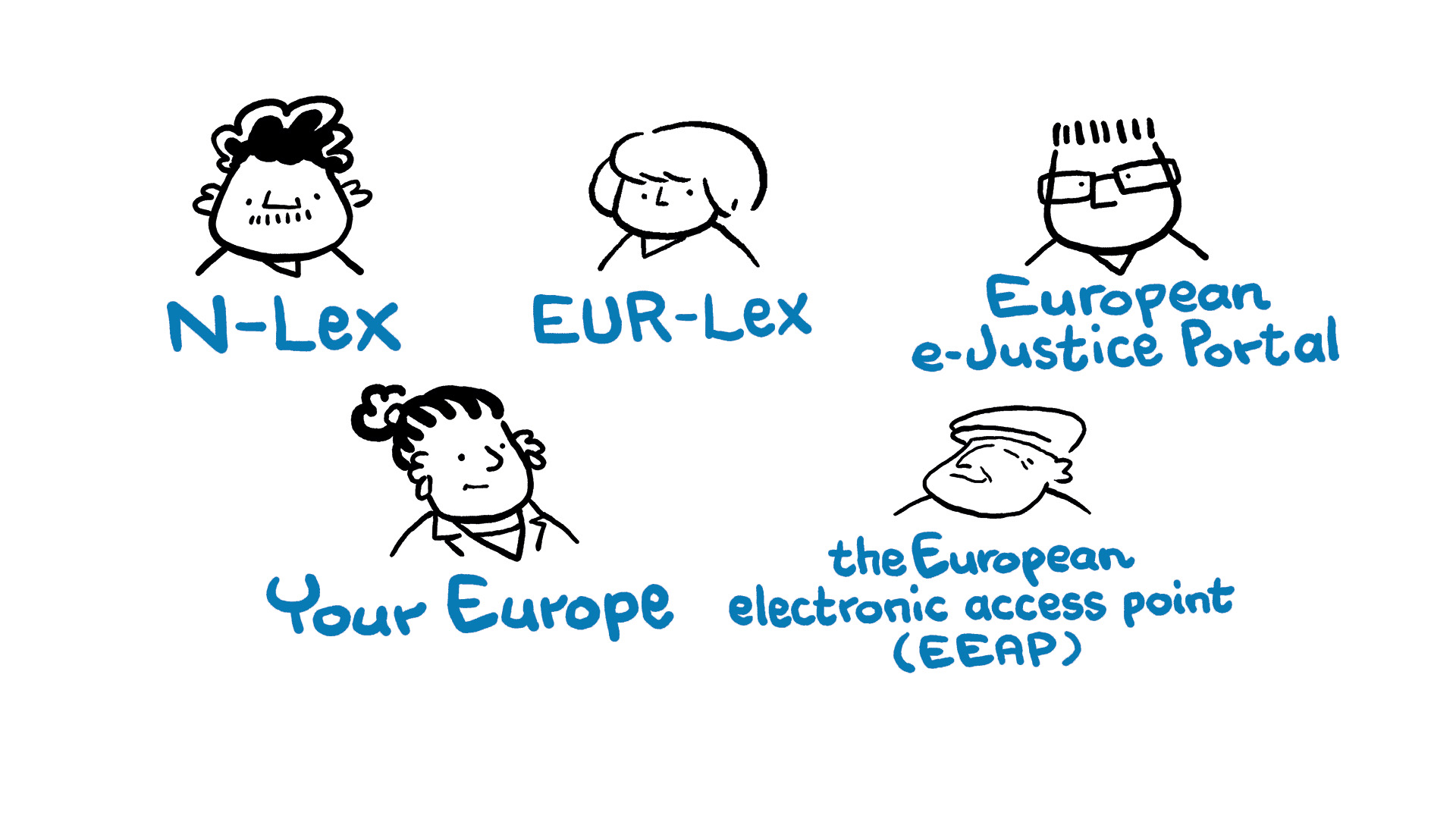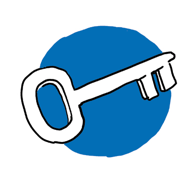5. Findings of work package 3: Versatile use of the Nordic and Baltic legal databases
Work package 3 (WP3), in the project Achieving the World’s Smoothest Cross-Border Mobility and Daily Life through Digitalisation funded by the Nordic Council of Ministers, focused on questions related to versatile use of Nordic and Baltic legal databases.
5.1 Legal information in machine-readable format
When discussing cross-border data exchange and interoperability in the field of legal data, the concept is somewhat different than studying abroad (see chapter 3 for more information) or needing your health-related information abroad (see chapter 4 for more information). In Nordic and Baltic countries, national legislation is country-specific, although the EU harmonisation of legislation has had impact on the regulation at the national level. Citizens do not take their home country’s regulations with them abroad but rather need to understand the local legislation in relation to the situation at hand. And should the person represent a private organisation or a public administrative body, the basic question remains the same: what the regulatory limitations are, and on the other hand, the regulatory possibilities in a specific country. Access to justice is closely connected to the access to legislation. Citizens of any Nordic or Baltic country have the right to access information on the legislative acts and their implementation in another Nordic or Baltic country. Thus, in a legal context the cross-border interoperability means sharing country-specific information on regulations and examples on how to interpret it.
Yet, just translating a regulation into another language is not a fully rational option. There are limitations to translating legislative documents; they cannot be translated word-for-word, nor can translation tools be used freely. The juridical force (legal validity) is connected only to the official legal languages of each country and the legislation will be assessed in court through those languages only, should there be cases of disagreements. Translated legal texts can though be used as an introduction to a country’s main regulatory principles. Using translated regulatory texts, European citizens can get a better understanding of other member states’ legal surroundings, whether for personal or business needs.

To be able to use the regulatory data more efficiently, the data has to be supported with context and background information – metadata, thesauri, and common formats. The adoption of metadata, thesauri, and common formats greatly facilitate the exchange and reuse of information. But to gain all the benefits from regulatory data with comprehensive metadata, providing access to that data online is not enough; providing the data in a machine-readable format enables development of advanced tools and services that will benefit both European citizens and organisations. It is the use of metadata and common data formats and publishing the data in a machine-readable format that enable interoperability and lead to both accurate interpretation of local legislation and concrete savings in time and money.
5.2 Standards and frameworks
To improve access to justice and legislative data in the Nordic and Baltic countries, there are several common standards and frameworks which can be used in the creation of legal information systems at the national level. These standards are fairly easy to implement and there are already a number of good practices and experiences in the utilisation of those standards. The following section introduces several standards and their key characteristics. In addition, the standards are introduced in Figure 21., where one can find which standards are used in each assessed country. (See chapter 2.1 Standards and frameworks for more information).
The European Legislation Identifier (ELI)
ELI includes technical specifications on web identifiers (Uniform Resource Identifiers, URIs) for legal information, metadata specifications for legal information, and a specific language for exchanging legislation in machine-readable formats. ELI is funded by the European Commission ISA2 programme.

Figure 22. Future visions of ELI according the ELI Task Force
ELI metadata is a structured, standardised way to describe legal data. It provides means for identifying, classifying, linking, and finding legal information. It also connects legal information to other pieces of information and enables users to access and reuse it. Being able to search and access legal information through metadata makes it much easier to locate and use a specific piece of information than having to search just the actual contents of the resource. A common metadata standard is a key to interoperability between legal information systems. Publishers of legal information are free to use their own metadata schemas but are encouraged to implement the ELI metadata schema as well.
Akoma Ntoso
Akoma Ntoso: http://www.akomantoso.org/
Open Graph Protocol (OGP)
Open Graph protocol http://www.ogp.me
Thesauri are controlled and structured vocabularies with concepts represented by labels with hierarchical structure of broader and narrower terms. Thesauri play a central role in managing metadata and describing information resources, supporting the use of multiple languages. Using them ensures consistent indexing, allowing users to find relevant information accurately. By aligning metadata with the hierarchical structure of thesauri, data integration and exchange become smoother, enhancing seamless interoperability between different systems and databases.
ELI meta-data | Dublin Core | Open Graph Protocol or Twitter metadata | Eurovoc | Keywords from national vocabulary | Endpoint for N-Lex search | |
Denmark (Retsinformation) | x** | no | x | no | x | x |
Estonia (Riigi Teataja) | x* | x | no | x | x | x |
Finland (Finlex) | x** | x | no | no | x | x |
Iceland (Stjornartidindi) | no | no | does not exist in Icelandic | x | IS is not included in N-Lex | |
Latvia (Likumi.lv) | no | no | x | x | ||
Lithuania (e-Seimas) | x * | no | no | x | x | |
Norway (Lovdata) | x* | no | does not exist in Norwegian | x | NO is not included in N-Lex | |
Sweden (Lagrummet) | no | no | no | no | no | x |
Figure 21. Table of applied standards within each assessed country
*Some ELI metadata properties
**ELI metadata in machine-readable RDF format
Remarks concerning the table: this table was compiled in the Pre-POC project and not all the data has been confirmed by the national contact point. There are differences in the use of metadata and thesauri in the Nordic and Baltic databases. The table does not include information from commercial databases. The data and languages of EEA countries Iceland and Norway are not included the Eurovoc thesaurus or in the N-Lex portal.
Eurovoc
Eurovoc: https://op.europa.eu/s/yWhr
Dublin Core

Figure 23. Standards: ELI, Dublin Core, Open Graph, EuroVoc, National Thesauri
5.3 Networks and stakeholders
This chapter provides an insight into the key networks and stakeholders that could be utilised when working with this topic. The chapter aims to present different European and Nordic-Baltic stakeholders and their role in the changing regulatory regime.
The European Forum of Official Gazettes
Forum of Official Gazettes: https://op.europa.eu/en/web/forum
The Nordic-Baltic Eight (NB8) is a regional co-operation format of Nordic and Baltic countries’ prime ministers, speakers of parliaments, foreign ministers, branch ministers, secretaries of state and political directors of foreign ministries. The formal co-operation agreement has been in place since 1992. In the justice sector, the ministries of justice of the Nordic and Baltic countries have been cooperating for example on topics related to judicial cooperation and the exchange of data between the information systems.
The ELI Task Force (ELI TF)
The ELI (European Legislation Identifier) ontology for draft legislation (abbreviated ELI-DL) is an extension of the core ELI ontology which provides a formal data model to disseminate structured data about legislative projects. In particular, it enables the structured annotation of existing web pages (using RDFa or JSON-LD) in order to turn their information into machine-readable data.
The aim is to support the following use-cases:
- easier and earlier data exchange between legal information systems; typically to enable Member States to know that an EU procedure foresees an impact on existing legislation, and prepare its transposition earlier;
- legal monitoring of legislative projects to be alerted early on the legislation being drafted;
- cross-link the description of the legislative project across multiple websites (typically OJ, parliament and committees websites);
- increased transparency to the public;
ELI-DL enables the description of the 3 following main entities :
- LegislativeProjects (eli-dl:LegislativeProject), from the initial proposal to the final publication in an OJ;
- LegalActivities (eli-dl:LegalActivity) occuring during the legislative projects, such as reading before a chamber.
- LegislativeProjectWorks (eli-dl:LegislativeProjectWork.
e-Codex is the main European tool for establishing an interoperable, secure, and decentralised communication network between national IT-systems in cross-border civil and criminal proceedings. It allows its users to electronically send and receive documents, legal forms, evidence, or other information in a secure manner. Its users can be judicial authorities, legal practitioners, and citizens.
A new horizontal EU regulation on the digitalisation of judicial cooperation and access to justice will enter into force stepwise between 2023-2029, covering over 20 legal instruments in civil and criminal proceedings of a cross-border nature within the EU. It would supplement horizontally, rather than replace, existing rules on digital delivery of documents, digital hearings and other uses of information technology (IT) for cross-border judicial cooperation. In principle, Member States’ competent judicial or other authorities would be under a duty to use digital channels of communication, whereas for individuals, the use of such channels would be optional.
Nobareg
5.4 Legislative info portals
There exist various different legislative info portals which serve both citizens, professionals and administrative bodies. For example, the European Union maintains several legislative portals: N-Lex, EUR-Lex, and European e-Justice, and in addition, the Your Europe portal that offers information on basic rights under EU law, provides access to network of national portals, as well as offering a free email or telephone contact for EU related assistance service and advice. These portals could benefit from access to legislative and judicial content as data. For instance, information portals often refer to sections of acts and decrees and display these to users.

N-Lex
For whom: N-Lex is for legal experts who need to compare legislation in several EU countries. N-Lex itself contains no documents, but the data in the national databases is linked to N-Lex. N-Lex complements EUR-Lex by linking EU law to the national law of its member states.
EUR-Lex
For whom: EUR-Lex is a portal for citizens, civil servants, and businesses, providing extensive information on EU legislation and EU processes.
The European e-Justice Portal
For whom: the e-Justice portal is for citizens, civil servants, judges and private companies, providing both information on judicial processes in all EU member states and access to several databases (e.g. to find a lawyer).
Your Europe
For whom: The primary audience for Your Europe are EU citizens and businesses, while N-Lex, EUR-Lex and European e-Justice Portal serve legal professionals and other experts in particular.
In 2025-2026 a new service will be introduced in the e-Justice portal, the European electronic access point (EEAP). It will be used for electronic communication between natural or legal persons and competent authorities in civil and commercial cases. The European Commission is responsible for the technical development and maintenance of the access point. The EEAP allows natural and legal persons to file claims, launch requests, send and receive procedurally relevant information and communicate with the competent authorities in any EU member state.
Suomi.fi is Finland’s official info portal. It is aimed to help citizens and entrepreneurs in different situations. It has compiled a vast variety of public services the information, instructions, and services in one portal.
Borger.dk is Denmark’s official guide to life in Denmark. It provides a single point of access to all public services whether they regard housing, working, family matters, taxes, transport, healthcare, education, or leisure.
Eesti.ee is Estonia’s official info portal that contains information and advice concerning different life events and situations for both citizens and entrepreneurs.
For whom: For EU citizens and businesses, who have the need to start a judicial process in another country (monetary claims etc.).
By using the national citizens’ info portals, it is possible to find relevant information for example on working, studying, and social security. National citizens’ info portals are a good way of finding relevant information for legislation related to life events. As an existing solution, info portals require no additional development or resources from those countries which have national info portals. Citizens’ info portals were studied in this work package’s cost-benefit analysis in 2022
By using the national citizens’ info portals, it is possible to find relevant information for example on working, studying, and social security. National citizens’ info portals are a good way of finding relevant information for legislation related to life events. As an existing solution, info portals require no additional development or resources from those countries which have national info portals. Citizens’ info portals were studied in this work package’s cost-benefit analysis in 2022
KPMG: Cost-benefit analysis of developing a shared interface between legal databases in the Nordic countries.
Valleala: Joint Nordic-Baltic Legal Search Interface – Pre-Proof-of-Concept Study.
In addition to national info portals, the states maintain databases where one can find laws, regulations, and court decisions. As an example, Finlex is currently undergoing a development (then: Semantic Finlex), where its contents are additionally in machine-readable format. The objective is to offer easily accessible and approachable legal information open to anyone, as well as harmonised and high-quality data for various applications. Subsequently, the users of Semantic Finlex are citizens and businesses or other actors which develop applications that require such data.
Finlex.fi is an online database of Finnish legislative and other judicial information. Finlex is a public service of Finland’s Ministry of Justice, and the database is available free of charge. Finlex has been available as public website since 1997. Technically the Finlex content is currently available for humans to read but not for machine-reading.
In 2024 Finlex will be renewed and published as linked open data on semantic web for intelligent web services. The goal is to ensure availability, accessibility, interoperability, and reusability of judicial data.
5.5 Proof-of-concept of the joint search interface for Nordic and Baltic legislative databases
Finland and Estonia are currently (2023) undertaking a proof-of-concept project to map out what kind of data requirements a common legislative interface between countries would have and what would be required of each country interested in participating in common legislative search interface and its development.
Establishing joint standards and principles for the development of legal databases in the Nordic and Baltic countries would significantly improve the availability and accessibility of information, as well as data interoperability in the future. The need for joint standards and principles is essential from the multitude of ongoing initiatives promoting cross-border data exchange on the EU-level, as well as the roadmaps published by existing search portals, such as N-Lex. The European Digital Strategy and EU Data Act (see Data Act on page 11 for more information), as well as SDG OOTS (see SDG OOTS on page 15 for more information) promote the sharing of information between public administration and citizens across the EU.
The benefits of utilising common standards include improvements in the quality, accessibility, and reliability of legislative data, in terms of both human and machine-readability. Utilising common standards should therefore be considered as a key goal in the future development of legal databases in all countries. The European Eli-standard is most prominent available standard for legal data. In the Nordic-Baltic countries only Finland, Norway, and Denmark have implemented ELI identifiers so far.
The proof-of-concept (PoC) taking place between Finland and Estonia in 2023 will provide valuable insight for establishing common standards and principles. In addition to providing information on the development requirements related to the standardisation of data sets, this PoC will also result in valuable hands-on experience other countries can utilise in their respective development efforts. The goal of the PoC phase is to identify the data requirements for a shared interface between countries and create a demonstrator of an application for retrieving information from Finland and Estonia’s legal databases. The PoC is aimed at testing the practical functionality of the search interface. The PoC complements text search with a faceted search. This allows user to search and filter documents based on metadata such as enforcement dates or keywords. The faceted search also shows all the available selections with their hit counts. Aalto University’s Semantic Computing research group carried out the PoC from March 2023 to November 2023.
The PoC demonstrator is a development version that that does not include all the features proposed in the pre-PoC, but it should be familiarised with when planning the entire implementation. The demonstrator is intended to be used for collecting feedback from users at an early stage in order to identify needs and requirements and develop the product. It is natural that after this, some questions may remain open or new questions may arise.
The Finnish LawSampo service was used as the basis for the development of the demonstrator. The data of the LawSampo is retrieved from the Finnish Semantic Finlex. Semantic Finlex includes texts and metadata of legislation in RDF format applying the Eli-standard. LawSampo uses a simplified data model derived from Semantic Finlex. Estonian statutes are published in XML format, but not using the Eli standard. This means that it was necessary to convert the Estonian data to the RDF format. The conversion was done only in the extent that what was essential for the PoC application. Because the data from Finland and Estonia was not published using the same standard, it required some work to understand the Estonian data format, and to create an automatic script for conversion.
Language technologies were used to enhance the search functionalities. The PoC uses keywords based on the European Eurovoc vocabulary. These keywords are added to the documents using language models. PoC uses translations that are created using language models when an existing translation has not been available.
The PoC applications show how legislation of two countries can be compared using same faceted search interface. This requires that data from both countries is converted to the same data model. Additionally, to use the search functionalities optimally, the vocabularies need to be the same. If all European legislation would be published using shared standards it would be essentially trivial to scale up the PoC to all countries. However, when common standards are not implemented the conversion work would need to be redone separately for every case.
The PoC makes it possible to search legislation using a keyword “travel”, for example, and the user will get statutes that are determined by the language model to relate to travelling in both Finnish and Estonian legislation. The user can also select a specific EU directive and get all the statutes relating to that directive from both Finland and Estonia. The PoC also includes simple tools to visualise the data.
5.6. Key take-aways
Establishing joint principles for future development between the Nordic and Baltic countries is vital to achieve the European goal of interoperability. Well-functioning national information systems are the starting point which function as a basis for further development for interoperability, harmonisation, and enhanced co-operation.
Until now, the Nordic, and Baltic countries have been developing their national legal information systems independently and the cross-border interaction between the development projects has been scarce. The sharing of good practices and examples on the use of metadata standards could be useful especially during ongoing development projects on legislative data.

When it comes to comparing the identified costs and benefits, many of the barriers identified in earlier studies that are currently preventing cross-border data exchange could be better addressed if there was a stronger mandate for the countries to direct resources into the development. Depending on the level of maturity of national information systems, the development required of each country to reach the common standards and compatibility may demand much stronger prioritisation in terms of resource allocation.
Implementing the ELI standard has thus far been based on voluntary action, which may explain its slow adoption across countries, even if the benefits of cross-border data exchange may have been clear. This could imply that when there is a “critical mass” of Nordic and Baltic countries using ELI standard, some of the identified barriers currently preventing cross-border data exchange could be significantly reduced. This further underlines the need for strong Nordic and Baltic collaboration and coordination related to the cross-border exchange of legislative data. The NB8 formation of Ministries of Justice of Nordic and Baltic countries and the ELI Task Force could serve as a platform for intensified cooperation. The benefits of easier access to legislative information are clear, not only making cross-border mobility and daily life easier for citizens, but also for finding a common voice among the Nordic and Baltic countries to share knowledge and contribute to EU-level discussions as an integrated region.
Implementing the ELI standard has thus far been based on voluntary action, which may explain its slow adoption across countries, even if the benefits of cross-border data exchange may have been clear. This could imply that when there is a “critical mass” of Nordic and Baltic countries using ELI standard, some of the identified barriers currently preventing cross-border data exchange could be significantly reduced. This further underlines the need for strong Nordic and Baltic collaboration and coordination related to the cross-border exchange of legislative data. The NB8 formation of Ministries of Justice of Nordic and Baltic countries and the ELI Task Force could serve as a platform for intensified cooperation. The benefits of easier access to legislative information are clear, not only making cross-border mobility and daily life easier for citizens, but also for finding a common voice among the Nordic and Baltic countries to share knowledge and contribute to EU-level discussions as an integrated region.
The mobility of citizens has rapidly increased after the Covid-19 pandemic. Therefore, it is necessary to share good practices and intensify cooperation on providing cross-border access to legislation in Nordic and Baltic countries
Of the existing search portals for legislative information, N-Lex has stated that ELI-standard is the most prominent alternative for text-based search features in the future. In the Nordic-Baltic countries only Finland, Norway, and Denmark have implemented ELI identifier so far. The benefits of utilising the ELI-standard include improvements in the quality, accessibility, and reliability of legislative data, in terms of both human and machine-readability. Utilising common standards, such as the ELI-standard should, therefore, be considered as a key goal in the future development of legal databases in all countries.
3. Tackling the identified barriers when developing cross-border data access and data exchange
The factors that are slowing down, preventing, or constraining data access and exchange of legislative data have been identified using the requirements of the European Interoperability Framework (EIF) (see EIF on page 12 for more information).
See chapter 2. The Ballpark and the key players
To make progress, it is necessary to emphasise benchmarking, knowledge sharing, sharing of good practices and common prioritisation between countries as important aspects in further development. The existing ELI standard, the rich metadata in the Akoma Ntoso and Dublin Core standards and the versatile Eurovoc thesaurus connected to national ontologies and the national info portals can be seen as key elements for providing cross-border access to legislative data. The experiences and solutions of the proof-of-concept will be made available to all Nordic and Baltic countries, with the intention to lower the threshold to starting new cross-border piloting projects on legislative data.
Using similar metadata standards and data formats will open new possibilities for future co-operation
References
- European Union. (2023). The European Legislation Identifier (ELI). Available: https://eur-lex.europa.eu/eli-register/about.html. Cited 28.7.2023.
- European Commission. (2021). ISA2 - Interoperability solutions for public administrations, businesses and citizens. Available: https://ec.europa.eu/isa2/home_en/. Cited 28.7.2023.
- United Nations. (2019). Akoma Ntoso. Available: http://www.akomantoso.org/ Cited 1.8.2023.
- The Open Graph protocol. (2023). Available: http://www.ogp.me. Cited. 29.9.2023
- Eurovoc. Available: https://op.europa.eu/s/yWhr. Cited 1.8.2023.
- Dublin Core. (2012). Available: https://www.dublincore.org/specifications/dublin-core/dces/. Cited 1.8.2023.
- European Union. (2023). European Forum of Official Gazettes. Available: https://op.europa.eu/en/web/forum. Cited 28.7.2023.
- European Union. (2017). Governance rules of the European Legislation Identifier Task Force (ELI TF) and processes to changes to ELI specifications. Available: https://eur-lex.europa.eu/content/eli-register/governance_rules.pdf. Cited 15.8.2023.
- European Council. (2021). Digitalisation of justice: Council presidency and European parliament reach provisional agreement on e-Codex. Available: https://www.consilium.europa.eu/en/press/press-releases/2021/12/08/digitalisation-of-justice-council-presidency-and-european-parliament-reach-provisional-agreement-on-e-codex/. Cited: 29.9.2023.
- Digdir. (2023). Nordic-Baltic working group on regulatory issues – Nobareg. Available: Nordic-Baltic working group on regulatory issues - Nobareg | Digdir. Cited 29.9.2023.
- Oksanen, A., Tuominen, J., Mäkelä, E., Tamper, M., Hietanen, A., Hyvönen, E. (2018). Semantic Finlex: Finnish Legislation and Case Law as a Linked Open Data Service. Available: https://seco.cs.aalto.fi/publications/2018/oksanen-et-al-lvi-2018.pdf. Cited 30.8.2023.
- European Union. (2023) N-Lex. Available: https://n-lex.europa.eu/n-lex/index. Cited 28.7.2023.
- European Union. (2023). EUR-Lex. Available: https://eur-lex.europa.eu/homepage.html. Cited 28.7.2023.
- e-Justice. (2023). Available: https://e-justice.europa.eu/home?action=home&plang=en. Cited: 29.9.2023.
- Your Europe. (2023). Available: https://europa.eu/youreurope/index_en.htm.Cited: 29.9.2023.
- KPMG. (2022). Cost-benefit analysis of developing a shared interface between legal databases in the Nordic countries.
- Valleala, A. (2022). Joint Nordic-Baltic Legal Search Interface – Pre-Proof-of-Concept Study.
- Semanttinen Finlex. (2023). Available: Semanttinen Finlex. Cited: 29.9.2023.
- See chapter 2. The Ballpark and the key players.